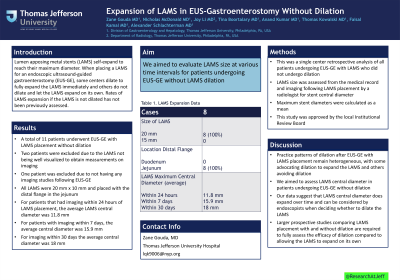Sunday Poster Session
Category: Interventional Endoscopy
P1023 - Expansion of LAMS in EUS-Gastroenterostomy Without Dilation
Sunday, October 27, 2024
3:30 PM - 7:00 PM ET
Location: Exhibit Hall E

Has Audio
- ZG
Zane Gouda, MD
Sidney Kimmel Medical College at Thomas Jefferson University
Philadelphia, PA
Presenting Author(s)
Zane Gouda, MD1, Nicholas McDonald, MD2, Joy Li, MD2, Tina Boortalary, MD2, Anand Kumar, MD, MPH2, Thomas Kowalski, MD1, Faisal Kamal, MD2, Alexander Schlachterman, MD1
1Sidney Kimmel Medical College at Thomas Jefferson University, Philadelphia, PA; 2Thomas Jefferson University Hospital, Philadelphia, PA
Introduction: Lumen apposing metal stents (LAMS) self-expand to reach their maximum diameter. When placing a LAMS for an endoscopic ultrasound-guided gastroenterostomy (EUS-GE), some centers dilate, to fully expand the LAMS immediately and others do not dilate and let the LAMS expand on its own. Rates of LAMS expansion if the LAMS is not dilated has not been previously assessed. We aimed to evaluate LAMS size at various time intervals for patients undergoing EUS-GE.
Methods: This was a single center retrospective analysis of all patients undergoing EUS-GE with LAMS who did not undergo dilation. LAMS size was assessed from the medical record and imaging following LAMS placement by a radiologist for stent central diameter. Maximum stent diameter were calculated as a mean. This study was approved by the local Institutional Review Board.
Results: A total of 11 patients underwent EUS-GE with LAMS placement without dilation. Two patients were excluded due to the LAMS not being well visualized to obtain measurements on imaging. One patient was excluded due to not having any imaging studies following EUS-GE. All LAMS were 20 mm x 10 mm and placed with the distal flange in the jejunum. For patients that had imaging within 24 hours of LAMS placement, the average LAMS central diameter was 11.8 mm. For patients with imaging within 7 days, the average central diameter was 15.9 mm and for imaging within 30 days the average central diameter was 18 mm.
Discussion: Practice patterns of dilation after EUS-GE with LAMS placement remain heterogeneous, with some advocating dilation to expand the LAMS and others avoiding dilation. We aimed to assess LAMS central diameter in patients undergoing EUS-GE without dilation. Our data suggest that LAMS central diameter does expand over time and can be considered by endoscopists when deciding whether to dilate the LAMS.
Note: The table for this abstract can be viewed in the ePoster Gallery section of the ACG 2024 ePoster Site or in The American Journal of Gastroenterology's abstract supplement issue, both of which will be available starting October 27, 2024.
Disclosures:
Zane Gouda, MD1, Nicholas McDonald, MD2, Joy Li, MD2, Tina Boortalary, MD2, Anand Kumar, MD, MPH2, Thomas Kowalski, MD1, Faisal Kamal, MD2, Alexander Schlachterman, MD1. P1023 - Expansion of LAMS in EUS-Gastroenterostomy Without Dilation, ACG 2024 Annual Scientific Meeting Abstracts. Philadelphia, PA: American College of Gastroenterology.
1Sidney Kimmel Medical College at Thomas Jefferson University, Philadelphia, PA; 2Thomas Jefferson University Hospital, Philadelphia, PA
Introduction: Lumen apposing metal stents (LAMS) self-expand to reach their maximum diameter. When placing a LAMS for an endoscopic ultrasound-guided gastroenterostomy (EUS-GE), some centers dilate, to fully expand the LAMS immediately and others do not dilate and let the LAMS expand on its own. Rates of LAMS expansion if the LAMS is not dilated has not been previously assessed. We aimed to evaluate LAMS size at various time intervals for patients undergoing EUS-GE.
Methods: This was a single center retrospective analysis of all patients undergoing EUS-GE with LAMS who did not undergo dilation. LAMS size was assessed from the medical record and imaging following LAMS placement by a radiologist for stent central diameter. Maximum stent diameter were calculated as a mean. This study was approved by the local Institutional Review Board.
Results: A total of 11 patients underwent EUS-GE with LAMS placement without dilation. Two patients were excluded due to the LAMS not being well visualized to obtain measurements on imaging. One patient was excluded due to not having any imaging studies following EUS-GE. All LAMS were 20 mm x 10 mm and placed with the distal flange in the jejunum. For patients that had imaging within 24 hours of LAMS placement, the average LAMS central diameter was 11.8 mm. For patients with imaging within 7 days, the average central diameter was 15.9 mm and for imaging within 30 days the average central diameter was 18 mm.
Discussion: Practice patterns of dilation after EUS-GE with LAMS placement remain heterogeneous, with some advocating dilation to expand the LAMS and others avoiding dilation. We aimed to assess LAMS central diameter in patients undergoing EUS-GE without dilation. Our data suggest that LAMS central diameter does expand over time and can be considered by endoscopists when deciding whether to dilate the LAMS.
Note: The table for this abstract can be viewed in the ePoster Gallery section of the ACG 2024 ePoster Site or in The American Journal of Gastroenterology's abstract supplement issue, both of which will be available starting October 27, 2024.
Disclosures:
Zane Gouda indicated no relevant financial relationships.
Nicholas McDonald indicated no relevant financial relationships.
Joy Li indicated no relevant financial relationships.
Tina Boortalary indicated no relevant financial relationships.
Anand Kumar: Boston Scientific – Consultant. Olympus – Consultant.
Thomas Kowalski: Boston Scientific – Consultant.
Faisal Kamal indicated no relevant financial relationships.
Alexander Schlachterman: Boston Scientific – Consultant. Fuji – Consultant. Laborie – Consultant. Lumendi – Consultant. Olympus – Consultant.
Zane Gouda, MD1, Nicholas McDonald, MD2, Joy Li, MD2, Tina Boortalary, MD2, Anand Kumar, MD, MPH2, Thomas Kowalski, MD1, Faisal Kamal, MD2, Alexander Schlachterman, MD1. P1023 - Expansion of LAMS in EUS-Gastroenterostomy Without Dilation, ACG 2024 Annual Scientific Meeting Abstracts. Philadelphia, PA: American College of Gastroenterology.
